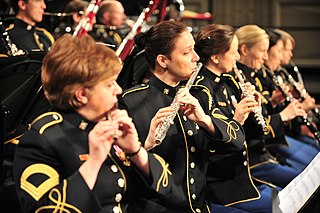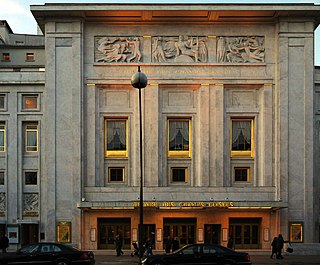Related Research Articles

A musical ensemble, also known as a music group or musical group, is a group of people who perform instrumental and/or vocal music, with the ensemble typically known by a distinct name. Some music ensembles consist solely of instrumentalists, such as the jazz quartet or the orchestra. Other music ensembles consist solely of singers, such as choirs and doo-wop groups. In both popular music and classical music, there are ensembles in which both instrumentalists and singers perform, such as the rock band or the Baroque chamber group for basso continuo and one or more singers. In classical music, trios or quartets either blend the sounds of musical instrument families or group instruments from the same instrument family, such as string ensembles or wind ensembles. Some ensembles blend the sounds of a variety of instrument families, such as the orchestra, which uses a string section, brass instruments, woodwinds, and percussion instruments, or the concert band, which uses brass, woodwinds, and percussion.
A piano sextet is a composition for piano and five other musical instruments, or a group of six musicians who perform such works. There is no standard grouping of instruments with that name, and compared to the string quartet or piano quintet literature, relatively few such compositions exist. The best-known piano sextet is probably the Sextet by Poulenc, one of the pinnacles of the wind and piano repertoire. Chausson's Concert is widely regarded as one of the masterpieces of French strings and piano chamber music literature.

A wind quintet, also known as a woodwind quintet, is a group of five wind players.
Alvin Derald Etler was an American composer and oboist.
Jean René Désiré Françaix was a French neoclassical composer, pianist, and orchestrator, known for his prolific output and vibrant style.
Walter Sinclair Hartley was an American composer of contemporary classical music.

William Waterhouse was an English bassoonist and musicologist. He played with notable orchestras, was a member of the Melos Ensemble, professor at the Royal Northern College of Music, author of the Yehudi Menuhin Music Guide "Bassoon", of The New Langwill Index, and contributor to the New Grove Dictionary of Music and Musicians.
Summer Music, Op. 31, is a classical composition for wind quintet by Samuel Barber.
The woodwind sextet Youth, (1924) is a chamber composition by Czech composer Leoš Janáček. It was composed for flute, oboe, clarinet, horn, bassoon and bass clarinet.
The Melos Ensemble is a group of musicians who started in 1950 in London to play chamber music in mixed instrumentation of string instruments, wind instruments and others. Benjamin Britten composed the chamber music for his War Requiem for the Melos Ensemble and conducted the group in the first performance in Coventry.
Gary Alan Kulesha is a Canadian composer, pianist, conductor, and educator. Since 1995, he has been Composer Advisor to the Toronto Symphony Orchestra. He has been Composer-in-Residence with the Kitchener-Waterloo Symphony (1988–1992) and the Canadian Opera Company (1993–1995). He was awarded the National Arts Centre Orchestra Composer Award in 2002.
Roger John Goeb was an American composer.

Graeme Peter Crump, known professionally as Peter Graeme and as 'Timmy' Crump to friends and family, was an English oboist and academic teacher. He was best known as the principal oboist of the Melos Ensemble.

The woodwind section, which consists of woodwind instruments, is one of the main sections of an orchestra or concert band. Woodwind sections contain instruments given Hornbostel-Sachs classifications of 421 and 422, but exclude 423
Victor Bruns was a German composer and bassoonist. He played with the Leningrad Opera, the Volksoper Berlin and the Staatskapelle Berlin. As a composer, he is known for his ballets and for bassoon concertos and sonatas.
Pamela Harrison was an English composer, pianist and music teacher.

The Sonate pour clarinette et basson, FP 32a, is a piece of chamber music composed by Francis Poulenc in 1922.
The Trio pour hautbois, basson et piano, FP 43, by Francis Poulenc is a three-movement chamber work, composed between 1924 and 1926, and premiered in the latter year.
The bassoon repertoire consists of pieces of music composed for bassoon as a principal instrument that may be performed with or without other instruments. Below is a non-exhaustive list of major works for the bassoon.
References
- ↑ Keller, James M. (November 2013). "Notes on the Program: Sextet for Wind Quintet and Piano / Trio for Oboe, Bassoon, and Piano" (PDF). New York Philharmonic . Retrieved February 8, 2016.
- 1 2 3 4 5 6 Grad, Aaron (2009). "Sextet for Piano and Wind Quintet". Saint Paul Chamber Orchestra . Retrieved February 8, 2016.
- 1 2 3 "Debussy, Françaix, Poulenc, and Ibert". Utah Symphony . Retrieved February 8, 2016.
- ↑ Mellers, Wilfrid Howard (1995). Francis Poulenc. Oxford University Press. ISBN 0-19-816338-X. OCLC 839028475.
- ↑ Werner, Warren Kent. The harmonic style of Francis Poulenc. OCLC 702714909.
- 1 2 3 4 5 6 7 "About This Recording: Francis Poulenc Complete Chamber Music, Volume 1". Naxos Records . Retrieved February 8, 2016.
- 1 2 3 4 Howard, Orrin. "Sextet (Francis Poulenc)". Los Angeles Philharmonic . Retrieved February 8, 2016.
- 1 2 3 4 5 Keller, James M. (November 2013). "Notes on the Program: Sextet for Wind Quintet and Piano / Trio for Oboe, Bassoon, and Piano" (PDF). New York Philharmonic . Retrieved February 8, 2016.
- 1 2 Keller, James M. (November 2013). "Notes on the Program: Sextet for Wind Quintet and Piano / Trio for Oboe, Bassoon, and Piano" (PDF). New York Philharmonic . Retrieved February 8, 2016.
- ↑ Krummeck, Judith (March 28, 2012). "Poulenc Plays!". WBJC . Retrieved February 8, 2016.
- ↑ Keller, James M. (November 2013). "Notes on the Program: Sextet for Wind Quintet and Piano / Trio for Oboe, Bassoon, and Piano" (PDF). New York Philharmonic . Retrieved February 8, 2016.
- ↑
- Hell, Henri; Edward Lockspeiser (trans) (1959). Francis Poulenc. New York: Grove Press. p. 59. OCLC 1268174.
- ↑ Francis Poulenc, The Fairfield Chamber Group - Sextet For Piano And Winds / Trio For Piano, Oboe And Basson / Sonata For Clarinet And Basson , retrieved 2022-04-30
- ↑ "Poulenc: Sextet for Piano and Wind Quintet, Op. 100 - Riegger: Concerto for Piano and Woodwind Quintet, Op. 53". Presto Music. Retrieved 2022-04-30.
- ↑ Taffanel, P.: Wind Quintet / Poulenc, F.: Sextet / Jolivet, A.: Serenade / Tomasi, H.: 5 Danses, 2009-06-30, retrieved 2022-04-30